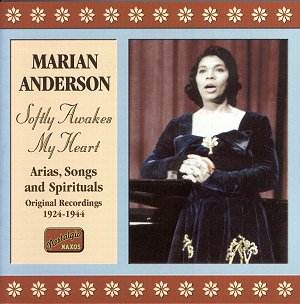 CD Reviews
CD Reviews MusicWeb
Webmaster: Len Mullenger
Len@musicweb.uk.net
[Jazz index][Purchase CDs][ Film MusicWeb][Classical MusicWeb][Gerard Hoffnung][MusicWeb Site Map]

MARIAN ANDERSON
SOFTLY AWAKES MY HEART
Arias, Songs And Spirituals. Original Recordings 1924 - 1944
Marian Anderson - contralto with various accompaniment.
![]() Naxos Nostalgia 8.120566
Naxos Nostalgia 8.120566
1. O don fatale - from Don Carlos
2. Tonight seeking hither my presence...
O love, from thy power - from Samson and Delilah
3. Softly awakes my heart - from Samson and Delilah
4. Pleurez mes yeux - from Le Cid
5. Deep River
6. My way's cloudy
7. Oh wasn't dat a wide ribber
8. Caro mio ben
9. He was despised - from The Messiah
10. Signore O Domine - from Te Deum
11. Aufenthault - from Schwanengesang
12. Der Tod und das Madchen
13. Laksin Mina - Tuku, Tuku
14. Saf, saf, susa
15. My soul's been anchored in the Lord
16. Let us break bread together
17. Trampin'
18. Lord, I can't stay - Heaven, heaven
19. I don't feel no ways tired
To include the works of Marian Anderson in a column of Jazz reviews might seem, at first glance, rather strange. However, the career of this singer reflects and parallels the evolution of Black American Music and her usage of certain song forms provides a common root source.
Marian Anderson was born in Philadelphia in 1897 and died in Portland, Oregon, in 1993. Between these dates occurred one of the most remarkable careers in the history of music. Peter Dempsey's excellent liner notes provide a concise overview of her life and career from the early days as a child prodigy to the greatly deserved honours of her later years including her operatic debut at the New York Met at the age of 58 , her performance at J.F. Kennedy's inaugural ball and her receipt of the American Freedom Medal from Lyndon B. Johnson.
Anderson was the first American female artist of her race to receive acceptance in her own country and to achieve this on the concert stage is even more remarkable. In the early part of the twentieth century Black performers were more or less restricted to the less salubrious venues such as the bar and the dancehall. Marian Anderson became an internationally admired singer as the wide range of places where these recordings were made serves to illustrate ( New York, Paris , London ).
The selections themselves vary from operatic arias, classical lieder and arias from religious works to spirituals and hymns. Anderson's rich contralto can be appreciated throughout, but it is possibly on the spirituals that an added sense of emotion can be felt. Her voice is highly expressive with great beauty particularly in her lower register and her diction is very clear, even taking into account the early date of some of these recordings. The accompaniment varies from a piano to a full orchestra and is highly complimentary on all selections .
As I stated at the beginning of this review, this is not Jazz but will, nevertheless, be appreciated by those who enjoy the sound of great singing.
Dick Stafford